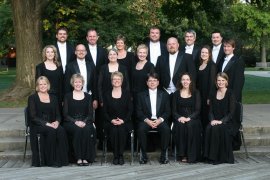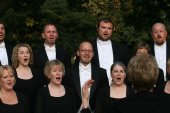 To understand the Degree of Difficulty inherent in the Nova Singers' season-opening concert, first imagine singing a particular vocal line - be it soprano, alto, tenor, or bass - against the three other vocal lines, and doing it a cappella, to boot.
To understand the Degree of Difficulty inherent in the Nova Singers' season-opening concert, first imagine singing a particular vocal line - be it soprano, alto, tenor, or bass - against the three other vocal lines, and doing it a cappella, to boot.
Then imagine singing your part while those four parts turn into eight.
Then imagine singing your part while those eight parts turn into 12.
And then, imagine staying on your part with 81 people around you attempting the exact same thing.
Such is the challenge for those performing in the Nova Singers' Cathedral Classics: Music for Double Choir, which finds the professional ensemble sharing the stage with the Knox Community Choir for some of the most demanding choral arrangements ever written. (Cathedral Classics will be performed at Galesburg's First Lutheran Church on October 27, and Moline's First Congregational Church on October 28.)
"It's been a vision that I've had - of the sound of these two groups combined - for a long, long time," says the Nova Singers' founder and director, Laura Lane. "And I thought this might be a good time to do it."
Since its origin in 1986, the Nova Singers have performed an annual eight-concert subscription series, recorded six albums, and worked with students through their educational outreach program "Project Sing!" Yet Lane - a Knox College professor of music, its director of choral activities, and its music-department chair - had never before attempted a performance on this scale, or one that incorporated such demanding compositions.
"It's a lot of work," she says, "and a lot of thought went into the teaching of the music. But as I've been doing this now for more than 25 years, I'm finding that while I'm very excited to go back and do something I've done before, I'm even more excited to do something I've never done."
"Music for double choir" is exactly that: works meant to be performed by two individual musical ensembles, yet performed simultaneously. What makes double-choir performances challenging, and rarely performed, is that the separated groups each sing a particular arrangement of a piece - with the SATB (soprano, alto, tenor, bass) sections often creating harmonies within those vocal sections - which then combine to form a wholly different arrangement.
The resulting harmonies can be thrilling to hear, yet with so many contrasting vocal parts being sung around you, are wildly difficult to perform, and with only 20 vocalists in the Nova Singers, Lane says the group was too small to do full justice to many double-choir arrangements.
 The idea for Cathedral Classics' merging of the Nova Singers with the 62 voices in the Knox College Choir originated when the professional ensemble was readying for a 2005 performance of Johann Sebastian Bach's St. John Passion, what Lane calls "the big event in the spring of our 20th-anniversary season.
The idea for Cathedral Classics' merging of the Nova Singers with the 62 voices in the Knox College Choir originated when the professional ensemble was readying for a 2005 performance of Johann Sebastian Bach's St. John Passion, what Lane calls "the big event in the spring of our 20th-anniversary season.
"When we do a big work like that," she says, "I study a lot of different works, and I also studied the St. Matthew Passion of Bach. And I was talking it over with some of the singers, and I was saying, 'You know, we can't do this repertoire; we can't do the St. Matthew because it's a double-chorus piece.' And they said, 'Why don't you put the Nova Singers together with the Knox College Choir? They've gotten so good.' Because it's not just that it [double-choir music] takes a lot of singers. It takes a fair number of really, really strong musician singers who can hold their own parts when you divide them."
However, the idea for a concert devoted to double-choir arrangements would have remained a hypothetical had Lane not found the ideal pieces of music.
One was Bach's motet Singet dem Herrn. "The motets are unusual in his repertoire," says Lane, "because he only wrote a few of them, and this one is considered to be the most difficult. It's in eight parts, but it's just very virtuosic music - there are lots and lots and lots of notes."
She adds that there was another, more personal reason for choosing the Bach piece, as Nova Singer Peggy Wrzesinski was asked to perform Singet dem Herrn at the funeral of her college choir director - a request that he, himself, made before passing.
"He wanted his former students to come back and sing this piece," says Lane. "With all of his knowledge of the repertoire, what he wanted at his funeral was this piece. That said something to me."
The other musical offering that spoke to Lane was Frank Martin's Mass for Double Choir, which the director says features "more divisi" than the Bach "because both choirs divide in several points. In the last movement, Choir One stays four-part pretty much, but Choir Two divides again into eight parts, so you have 12-part music. It's really hard."
Martin's piece also has historical significance in that it was a work the French-Swiss composer completed, locked in a drawer, and only released at the urging of his best friend, a noted conductor, some 40 years later.
"Reporters asked him, 'Why did you put it away?'" says Lane. "'This is incredible music; why didn't you publish it?' And he said, 'When I finished it, I didn't want it to be subject to scrutiny. ... I didn't want people to judge it on its artistic merits. To me, it seemed like a personal experience between myself and God.'
"So I started looking at the piece more, and listening to the recording more, and I started thinking, 'You know, this music is so challenging, it's so difficult, it's not done very often ... . I kinda want to do it!"'
Happily for Lane, the Nova Singers and Knox College Choir members are wanting to do it, as well. "From the very first rehearsal," she says, "both groups fell madly in love with the music. Other than one or two singers, nobody knew the Bach, and none of them knew the Martin. They're discovering along with me the beauty and the power of this music. It's just extraordinary."
 Lane adds that the rehearsal process has also been rather extraordinary, particularly for the younger voices in the Knox College Choir. "For the first time ever," she says, "I had the students come back before classes began, and they worked for about 15 hours - three or four hours in the evening, or two in the afternoon and two in the evening, for four days in a row. And these kids just sang their hearts out; they sang and sang and sang. I've never had the start of a year feel so intense and exciting, because they were so committed to getting ready for the Nova Singers."
Lane adds that the rehearsal process has also been rather extraordinary, particularly for the younger voices in the Knox College Choir. "For the first time ever," she says, "I had the students come back before classes began, and they worked for about 15 hours - three or four hours in the evening, or two in the afternoon and two in the evening, for four days in a row. And these kids just sang their hearts out; they sang and sang and sang. I've never had the start of a year feel so intense and exciting, because they were so committed to getting ready for the Nova Singers."
The early rehearsals, Lane says, required as many as four piano accompanists, "because we had to split up into four different sectionals to learn all the notes." (Pianists, understandably, "can't play all the parts on top of each other's fingers.") And once the music was learned, she adds with a laugh, "it's up to me to stand in front and hear if they're doing it correctly. I have to polish it - get them to sound happy when the music's really happy, get them to sound really sad without going out of tune - and get the balance right."
One would think that Cathedral Classics' selections would constitute enough of a challenge, but Lane chose to add another one by splitting her ensembles into halves - 10 Nova Singers and 31 college-choir members performing in Choir One, and the same breakdown for Choir Two - to provide the individual choirs with a better blend. The decision led to what Lane calls "a nightmare of organization, to try to get everybody on the same page," but one she feels right in making.
"Several people asked me, 'Why didn't you just teach Nova Singers one choir, and then teach the college group the other choir, and then put them together?' Well, yeah, that would've been the easy way to do it," she says with a laugh. "But do I ever choose the easy way out? No. I never do. I'll do the hardest thing for me and the singers if, in the long run, I think it will sound better. And the last few weeks, as I've been listening to them rehearse, I just can't help but smile.
"I love challenging myself," Lane continues, "and this is a challenge - to hear all the music when it's going on, and to try to figure out what needs my help. And as hard as it's been for them to learn the music and for me to teach it to them, oh my gosh, when I imagine what it's gonna sound like to put those two groups together ... !"
Cathedral Classics: Music for Double Choir will be performed at Galesburg's First Lutheran Church (364 East Water Street) at 7:30 p.m. on Saturday, October 27, and at Moline's First Congregational Church (2201 Seventh Avenue) at 4 p.m. on Sunday, October 28. For more information, call (309) 341-7038 or visit (http://deptorg.knox.edu/novasingers).










